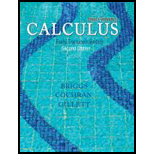
Concept explainers
Gliding mammals Many species of small mammals (such as flying squirrels and marsupial gliders) have the ability to walk and glide. Recent research suggests that these animals choose the most energy-efficient means of travel. According to one empirical model, the energy required for a glider with body mass m to walk a horizontal distance D is 8.46 Dm2/3 (where m is measured in grams, D is measured in meters, and energy is measured in microliters of oxygen consumed in respiration). The energy cost of climbing to a height D tan θ and gliding a distance D at an angle θ below the horizontal is modeled by 1.36 m D tan θ (where θ = 0 represents horizontal flight and θ > 45° represents controlled falling). Therefore, the function
gives the energy difference per horizontal meter traveled between walking and gliding: If S > 0 for given values of m and θ, then it is more costly to walk than glide.
- a. For what glide angles is it more efficient for a 200-gram animal to glide rather that walk?
- b. Find the threshold function θ = g(m) that gives the curve along which walking and gliding are equally efficient. Is it an increasing or decreasing function of body mass?
- c. To make gliding more efficient than walking, do larger gliders have a larger or smaller selection of glide angles than smaller gliders?
- d. Let θ = 25°, (a typical glide angle). Graph S as a function of m, for 0 ≤ m ≤ 3000. For what values of m is gliding more efficient?
- e. For θ = 25°, what value of m (call it m*) maximizes S?
- f. Does m*, as defined in part (e), increase or decrease with increasing θ? That is, as a glider reduces its glide angle, does its optimal size become larger or smaller?
- g. Assuming Dumbo is a gliding elephant whose weight is 1 metric ton (106 g), what glide angle would Dumbo use to be more efficient at gliding than walking?
(Source: Energetic savings and the body size distribution of gliding mammals, R. Dial, Evolutionary Ecology Research 5, 2003)
Want to see the full answer?
Check out a sample textbook solution
Chapter 4 Solutions
Single Variable Calculus: Early Transcendentals (2nd Edition) - Standalone book
Additional Math Textbook Solutions
Introductory Statistics
Thinking Mathematically (6th Edition)
A Problem Solving Approach To Mathematics For Elementary School Teachers (13th Edition)
A First Course in Probability (10th Edition)
Elementary Statistics (13th Edition)
Basic Business Statistics, Student Value Edition
- the correct answer is C could you please explainarrow_forwardWhich of the functions shown below is differentiable at z = 2? Select the correct answer below: о -7-6-5-4-3-2- −7 −6 −5 −4 −3-2 1 2 4 5 6 -7-6-5-4-3-2- -7-6-5-4-3 2 45arrow_forwardQuestion Given the graph of f(z) below, find the graph of the derivative of f(z). Select the correct answer below: ° ° 129 -7-6-5-4-3-2 -7-6-5-4-3-2-1123456 ° ° °arrow_forward
- Question Find the open interval(s) of f(x), graph given below, where f'(x) is negative. -3-2-1 1 2 4 5 6 Give your answer in interval notation. For example, (2, 4) U (6,∞). Provide your answer below:arrow_forwardthe correct answer is Ccould you please show me how to do it using the residue theoremarrow_forwardUse the information to find and compare Δy and dy. (Round your answers to four decimal places.) y = x4 + 7 x = −3 Δx = dx = 0.01 Δy = dy =arrow_forward
- Algebra & Trigonometry with Analytic GeometryAlgebraISBN:9781133382119Author:SwokowskiPublisher:Cengage
 Glencoe Algebra 1, Student Edition, 9780079039897...AlgebraISBN:9780079039897Author:CarterPublisher:McGraw Hill
Glencoe Algebra 1, Student Edition, 9780079039897...AlgebraISBN:9780079039897Author:CarterPublisher:McGraw Hill Functions and Change: A Modeling Approach to Coll...AlgebraISBN:9781337111348Author:Bruce Crauder, Benny Evans, Alan NoellPublisher:Cengage Learning
Functions and Change: A Modeling Approach to Coll...AlgebraISBN:9781337111348Author:Bruce Crauder, Benny Evans, Alan NoellPublisher:Cengage Learning


